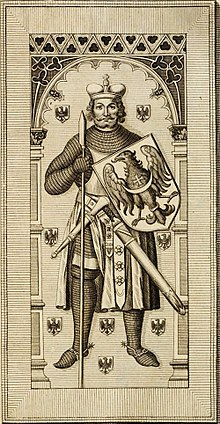Boleslaw I. (Silesia)

Boleslaw I. (also: Boleslaus der Lange ; Boleslaus I von Schlesien ; Polish: Bolesław I. Wysoki ; * 1127 ; † December 18, 1201 ) was Duke of Silesia with his seat in Wroclaw .
Origin and family
Boleslaw came from the Polish ruling dynasty of the Piasts . His father Władysław II “the expellee” († 1159) was the founder of the Silesian Piast line . Boleslaw's mother was Agnes von Babenberg (approx. 1111–1163), daughter of the Austrian Margrave Leopold III. Boleslaw's brothers were:
- Mieszko I († 1211), Duke of Silesia, from 1202 Duke of Opole
- Conrad I († after 1178), Duke of Silesia
- Boleslaw's sister Richeza had been married to King Alfonso VII of Castile since 1152 .
1163 married Boleslaw Wenzlawa ( Zvinislava / Anastasia ), daughter of Vsevolod II of Kiev . From this marriage came:
- Jaroslaw († 1201), Duke of Opole, from 1198 Bishop of Breslau.
After Wenzlawa's death, Boleslaw married Adelheid, daughter of Count Palatine Berengar von Sulzbach . This marriage had four sons and two daughters, including:
- Heinrich I († 1238), Duke of Silesia and Duke of Poland
- Adelheid, married to Margrave Diepold III. from Moravia
Life
Boleslaw was expelled from his uncle Bolesław Kraushaar († 1173) in 1146 together with his parents and his brother Mieszko. After the family at the court of the Roman-German King Konrad III. Found acceptance, Boleslaw spent his youth on the imperial palatinate Altenburg in Thuringia . Together with King Konrad III. Boleslaw took part in the Second Crusade in 1147 . In 1154/1155 and 1158/1162 he accompanied Emperor Friedrich I Barbarossa on his Italian trains.
It was only four years after their father's death that Boleslaw and Mieszko were allowed to return to Silesia in 1163 with the help of Emperor Frederick I, which their uncle, Duke Bolesław IV. Had to give them "Kraushaar" . They received their territory within the Polish seniority constitution as an independent duchy and had to pay tribute to the emperor. They ruled their territory, which included Central and Lower Silesia and the Opole region, initially together. In 1172 Boleslaw was exiled again by his uncle Boleslaw Kraushaar, but returned in 1173 again with the help of the Emperor Barbarossa.
After a dispute between the brothers, the land was divided. Boleslaw received Central and Lower Silesia with the areas of Liegnitz, Breslau and Opole. The Glogau country he ruled probably as guardian of his underage brother Konrad. Mieszko received the Upper Silesian territories from Ratibor and Teschen . Since Boleslaw wanted to regain the throne of Cracow as head of the older Piast line , he participated in the conspiracy against the then senior Mieszko III in 1177 . "The old man", which is why he was expelled by this. Only with the help of the new senior duke, Casimir the Just , was Boleslaw able to return. Kasimir gave Mieszko the areas of Bytom , Auschwitz , Zator , Sewerien and Pless .
After Boleslaw had designated his son Heinrich as the sole heir, Jaroslaw, the son of Boleslaw's first marriage, revolted against his father. Together with his uncle Mieszko, Jaroslaw fought against his father, who finally assigned him the Opole area as a duchy for life in 1180 . In return, Jaroslaw had to undertake to enter the clergy. After Yaroslav's death on March 22, 1201, the Duchy of Opole fell back to Boleslaw in accordance with the treaty. Since Boleslaw followed his son Yaroslav in death on December 18 of the same year, his brother Mieszko conquered the Opole region a few months later and linked it permanently with his dominion.
During his reign, Boleslaw campaigned for the development of the country and promoted the colonization of the country with German settlers ( Deutsche Ostsiedlung ). His 17-year stay in exile in the imperial palace in Altenburg may have played a role in this. In the following two hundred years, the immigrants founded around 1200 villages and 120 cities under German city law .
In 1175 he issued the deed of foundation for the Leubus Monastery , which had been settled by Cistercians from Pforta in Saxony as early as 1163 . He is said to have previously expelled Polish Benedictines from Leubus with papal approval. With Boleslaw's consent, the Breslauer Vincentstift on the Elbing was handed over to the Premonstratensians . He was buried in the Leubus Monastery.
literature
- Colmar Grünhagen: Boleslaw, the tall one . In: Allgemeine Deutsche Biographie (ADB). Volume 3, Duncker & Humblot, Leipzig 1876, pp. 98-100.
- Hans Jürgen Rieckenberg: Boleslaw I, the Tall One , Duke of Silesia. In: New German Biography (NDB). Volume 2, Duncker & Humblot, Berlin 1955, ISBN 3-428-00183-4 , p. 430 ( digitized version ).
- Historical Commission for Silesia (Ed.): Geschichte Schlesiens , Vol. 1, Sigmaringen 1988, ISBN 3-7995-6341-5 , pp. 86-91
- Hugo Weczerka (Hrsg.): Handbook of the historical places . Volume: Silesia (= Kröner's pocket edition . Volume 316). 2nd, improved and enlarged edition. Kröner, Stuttgart 2003, ISBN 3-520-31602-1 .
Individual evidence
- ↑ Hugo Weczerka (Ed.): Handbook of historical sites. Volume: Silesia (= Kröner's pocket edition. Volume 316). 2nd, improved and enlarged edition. Kröner, Stuttgart 2003, ISBN 3-520-31602-1 , p. 277.
| personal data | |
|---|---|
| SURNAME | Boleslaw I. |
| ALTERNATIVE NAMES | Boleslaus I of Silesia, Boleslaus the Long; Bolesław I. Wysoki (Polish) |
| BRIEF DESCRIPTION | Duke of Silesia |
| DATE OF BIRTH | 1127 |
| DATE OF DEATH | December 18, 1201 |